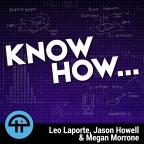
Oct 9th 2014
Know How... 114
Fiber Tapping, Hybrid vs. SSD, and Linux Terminal
Kano DIY Computer, Fiber Tapping, Hybrid vs. SSD, Aircraft Basics, & Linux Terminal
The semi-DIY computer named "Kano", Fiber Tapping, Hybrid HD vs SSD, basic Linux terminal commands, and aircraft basics.
Kano A REALLY expensive, kinda-DIY computer
It was a Kickstarter that wen't WAY beyond their $100k goal. ($1.5 million)
The idea is simple: Give kids (and adults) a kit that let's them build their own computer.
The Kit consists of
- A Raspberry Pie ($40)
- A custom-color case ($5)
- A speaker ($2)
- A Wireless keyboard/mouse ($10)
- A power adapter ($1)
- HDMI cable ($2)
- WiFi dongle ($5)
- SD Card with "Kano" OS (Derrivant of Linux) ($10)
Interesting idea... but the parts list is a little suspect.
- The parts cost AT MOST $75. (Not taking into account and bulk discounts they may get)
- So it's $75 for the Kano OS?
- And it's not really "building" your own computer" -- It's plugging it in.
Hybrid HD vs. SSD
What if we REALLY built our own computer?
- MSI AM1I AM1 HDMI SATA 6Gb/s USB 3.0 Mini ITX AMD Motherboard $30.00
- AMD Sempron 2650 $31.00
- Crucial 2GB 240-Pin DDR3 SDRAM DDR3 1600 (PC3 12800) Desktop Memor $20.00
- WD 80GB SATA 7200rpm HD $14.00
- Mini ITX Case and 250W PS $30.00
- Optical Drive $14.00
- Keyboard/Mouse/HDMI Cable $11.00
$150 (All items ordered via Amazon Prime with no tax to California)
There are two types of Hybrid Drive setups:
- Dual Drive:
-- A SATA connected HDD and a SAtA or mSATA connected SSD that are made to look like a single drive to the host computer. - SSHD (Solid State Hybrid Drive)
-- A Single SATA connected device that combines NAND Flash memory (SSD) inside a hard drive.
Either Hybrid Drive setup works on the same principle: Using a small (and therefore more affordable) ammount of high-speed NAND flash memory to cache the most commonly used pieces of data on the drive. In PRINCIPLE, this can give you the speed of a SSD, but the higher capacity and affordability of a rotating drive.
Both systems can operate in either "Self-Optimized" mode or "Pinning Mode". In the "Self-Optimized" mode, the drive subsystem makes the decisions about what to place in flash memory based on the block activity on the hard drive. (It DOESN'T store particular files... but parts of the drive.) In the "Host-Optimized" or "Pinning " mode, the OS can use extended SATA commands to let the OS decide what to place in flash.
But here's the thing:
- 18 months ago I benchmarked the Samsung 470 SSD
- Fast for a SSD of its time:
- 47MB/s Read
- 216MB/s Write
But it was expensive! --- $250 for a 120GB model. Much more affordable was the Seagate Momentus XT. 8GB of NAND Flash memory on top of a 500GB rotating Hard Drive. $120 for a 500GB model
- 110MB/s Read
- 60MB/s Write
But because system components were what they were... most systems didn't really take advantage of the speed of an SSD, and the Hybrid drive could get you 70% of the performance boost of a SSD, but at less than half the price, and with 4x the storage.
Now however... the gap has widened:
- A KC300 will do 525MB/s Read & 500MB/s write
- Modern systems now have SATA r3 which will support up to 600GB/s
- But a modern Seagate Momentus Hybrid will still only do ~110MB/s and 80MB/s
Even going budget:
- You can find several budget 120GB SSDs for ~$60 that will hit 400/400
- You can find a 4TB HD for ~$130
- A 4TB SSHD will cost ~$170
Are you REALLY going to sacrifice ~80% of your performance for $20? That's only a 11% increase in drive cost. If your have a system that costs $1000, that's only a 2% cost difference that could potentially kill up to 50% of your performance.
EVEN IF YOU HAVE A 1-BAY LAPTOP! If you have USB 3, eSATA or Thunderbolt: Those interfaces are faster than the max speed of a hard drive... so why not have a crazy-fast internal drive and use a slower external?
Connect with us!
Don't forget to check out our large library of projects at https://twit.tv/shows/know-how.
Tweet at us at @padresj, @Cranky_Hippo, and @Anelf3




